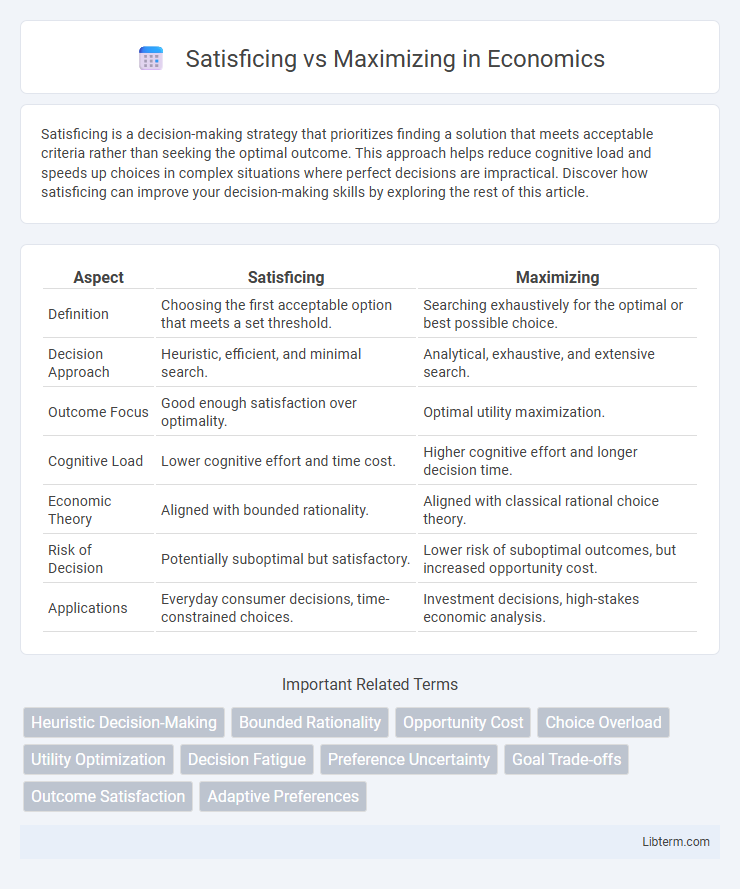Satisficing is a decision-making strategy that prioritizes finding a solution that meets acceptable criteria rather than seeking the optimal outcome. This approach helps reduce cognitive load and speeds up choices in complex situations where perfect decisions are impractical. Discover how satisficing can improve your decision-making skills by exploring the rest of this article.
Table of Comparison
| Aspect | Satisficing | Maximizing |
|---|---|---|
| Definition | Choosing the first acceptable option that meets a set threshold. | Searching exhaustively for the optimal or best possible choice. |
| Decision Approach | Heuristic, efficient, and minimal search. | Analytical, exhaustive, and extensive search. |
| Outcome Focus | Good enough satisfaction over optimality. | Optimal utility maximization. |
| Cognitive Load | Lower cognitive effort and time cost. | Higher cognitive effort and longer decision time. |
| Economic Theory | Aligned with bounded rationality. | Aligned with classical rational choice theory. |
| Risk of Decision | Potentially suboptimal but satisfactory. | Lower risk of suboptimal outcomes, but increased opportunity cost. |
| Applications | Everyday consumer decisions, time-constrained choices. | Investment decisions, high-stakes economic analysis. |
Understanding Satisficing and Maximizing
Satisficing involves selecting the first option that meets a predefined threshold of acceptability, prioritizing efficiency and reducing decision fatigue, whereas maximizing entails exhaustively searching through all possible options to identify the absolute best choice. Understanding satisficing highlights its role in streamlining decision-making by balancing quality with cognitive effort, while maximizing emphasizes thoroughness and optimality, often at the cost of increased time and potential dissatisfaction. Recognizing the differences between these strategies is crucial for applying them effectively in contexts such as consumer behavior, resource management, and problem-solving.
Psychological Origins of Decision-Making Styles
Satisficing and maximizing represent distinct psychological decision-making styles arising from cognitive processing differences and individual tolerance for uncertainty and effort. Satisficers tend to prioritize adequate solutions that meet acceptable criteria, minimizing cognitive overload and decision fatigue, whereas maximizers seek the optimal choice by exhaustively evaluating options, driven by higher sensitivity to regret and perfectionism. These styles are influenced by personality traits, cognitive capacities, and environmental factors that shape how individuals balance speed, accuracy, and satisfaction in decision-making.
Key Differences: Satisficers vs Maximizers
Satisficers prioritize decisions that meet an acceptable threshold of satisfaction, often choosing options that are "good enough" to conserve time and reduce stress, whereas maximizers strive to identify the absolute best choice by exhaustively evaluating all possible alternatives. Satisficers tend to experience greater contentment and lower regret due to their practical approach, while maximizers frequently face increased anxiety and indecision caused by overanalyzing options. The key difference lies in decision-making strategies: satisficers aim for efficiency and adequacy, and maximizers pursue optimality and thoroughness.
Real-Life Examples of Satisficing and Maximizing
In everyday decision-making, satisficing occurs when a shopper chooses the first laptop that meets their performance and budget criteria, avoiding exhaustive comparison to save time. Conversely, maximizing is exemplified by a job seeker who diligently researches multiple companies, compares salaries, benefits, and culture, aiming to secure the best possible offer. These contrasting approaches influence satisfaction and efficiency, with satisficers favoring sufficient solutions and maximizers striving for optimal outcomes.
Benefits and Drawbacks of Satisficing
Satisficing involves choosing an option that meets minimum criteria, which benefits decision-makers by reducing cognitive load and saving time in complex situations. This approach minimizes stress and indecision by avoiding exhaustive comparisons inherent in maximizing, where one seeks the absolute best outcome. However, satisficing risks settling for suboptimal results and missed opportunities, potentially leading to less favorable long-term consequences compared to maximizing strategies.
Pros and Cons of Maximizing
Maximizing involves seeking the best possible outcome by thoroughly evaluating all available options, which can lead to optimal decisions and higher satisfaction with chosen results. However, this approach can cause decision paralysis, increased stress, and dissatisfaction due to the fear of missing better alternatives. Despite its potential for improved outcomes, maximizing often demands significant time and cognitive effort, making it less efficient in situations requiring quick decision-making.
Decision Fatigue: A Result of Maximizing?
Maximizing decision styles often lead to decision fatigue due to the exhaustive search for the optimal choice, increasing cognitive load and stress. Satisficing, by accepting a "good enough" option, reduces mental effort and conserves decision-making resources, minimizing fatigue. Research indicates that individuals who adopt satisficing experience lower levels of anxiety and burnout compared to maximizers facing extensive options.
Factors Influencing Satisficing and Maximizing Behavior
Cognitive load and time constraints significantly influence whether individuals adopt satisficing or maximizing strategies in decision-making. High cognitive load and limited time promote satisficing behavior, where individuals seek an acceptable solution rather than the optimal one. Personality traits, such as maximizers' tendency for extensive information search and perfectionism, also shape the preference for maximizing over satisficing.
Impact on Happiness and Life Satisfaction
Satisficing, the strategy of choosing an option that meets acceptable criteria, often leads to greater happiness and life satisfaction by reducing decision anxiety and regret. Maximizing involves exhaustively searching for the best possible choice, which can increase stress and lower overall contentment due to higher expectations and second-guessing. Studies in psychology consistently show that satisficers report higher well-being and less decision-related stress compared to maximizers.
Strategies to Balance Satisficing and Maximizing
Effective decision-making involves balancing satisficing--seeking "good enough" solutions--with maximizing, which aims for the optimal outcome. Implementing strategies such as setting clear criteria for acceptable options, prioritizing decisions based on their impact, and allocating time limits for evaluations helps optimize the trade-off between thoroughness and efficiency. Utilizing decision frameworks like cost-benefit analysis and satisficing thresholds allows individuals to streamline choices without compromising on key goals.
Satisficing Infographic

 libterm.com
libterm.com